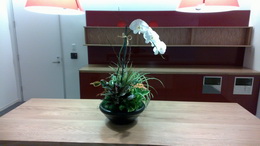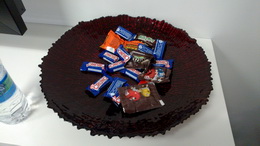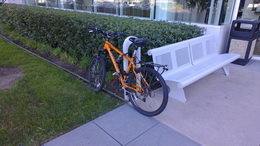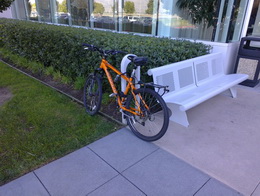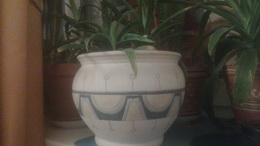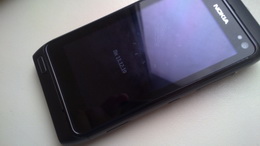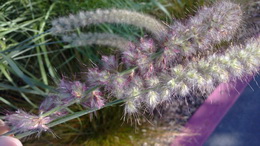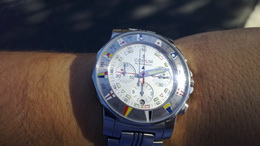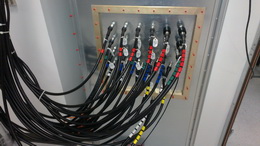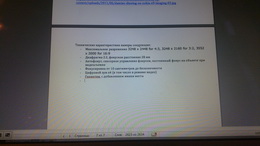Review of Nokia N9 GSM/UMTS Smartphone. Part I
Live photos of Nokia N9
Contents:
- In the box
- Positioning
- Design, Dimensions and Controls
- Screen
- Battery
- Memory and Storage
- Connectivity. Bluetooth, USB, WiFi, NFC
- Camera
In the box:
- Nokia N9
- Nokia USB AC-16 charger
- Nokia CA-185CD cable for charging and data transfer
- Nokia WH-207 stereo headset
- Case
- User Guide
- Promotional brochure
Positioning
Nokia views the device as its flagship, which is surprising, because Stephen Elop mentioned in his interview for the Finnish periodical Helsingin Sanomat, that no matter what sales will the product achieve this is the last Meego smartphone and Nokia will use OS from Microsoft afterwards. The official announcement of the smartphone took place on June 21, 2011 in Singapore with the promise to start sales at the end of August. The company failed to keep its promise and the model hit the shelves on October 6. Before describing the positioning in earnest we need to know what MeeGo and Nokia N9 are about.
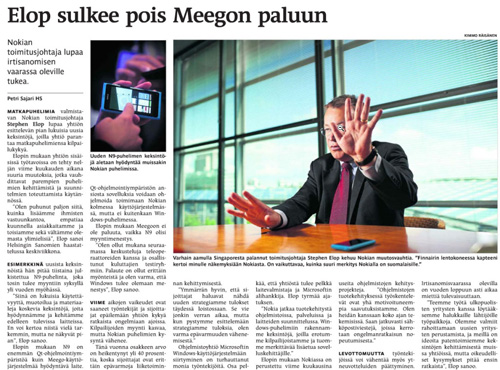
Nokia began working on a new OS for smartphones as early as 2004 and it was an experiment in the area of touchscreens. In 2007 Apple launched iPhone and Nokia started working faster and harder on Maemo (it was the name of the OS at the time) considering it to be an adequate answer to the Apple product. Nevertheless, the existing models like Nokia N800 or N900 could not even compete with other Symbian solutions let alone with the iconic Apple iPhone. Consequently, the company started developing Maemo/MeeGo. Total investment in 2010 alone reached 300 million Euros and more than 1 billion Euros over the last two years. The arrival of Stephen Elop meant that Nokia was not going to pursue this area though.
Interestingly, but Nokia decided to get rid of the potentially advanced and modern OS. By the time Nokia N9 was ready for the launch the OS became more error free and the phone had all chances to impress global consumers. What’s more, it was cheaper for Nokia to support the model and the entire project than to make sensational moves to derail the potential success of Nokia N9 before the sales started. Who will buy a product, which is promised by the manufacturer not to be supported or developed? The answer is blowing in the wind.
Instead the top management of Nokia banks everything on another OS, while N9 is dubbed as the last product in the line. At the same time the company invests heavily in advertising Nokia N9 as if it is a true flagship. Actions contradict announcements, which creates additional confusion. The delay of N9 led to a strange situation when over a month consumers were attacked by dozens of ads only to realize when they enter the stores that the phone is not there yet. It was happening against the background of new and more mature rival solutions emerging on the market, which was a dangerous negligence indeed.
Nokia cannot decide on its attitude to N9. On the one hand it had to start the whole new product line, but according to the soundbites from Nokia’s top brass this was not going to happen. On the other hand sales were boosted by promising the Meego support until 2016. This is a traditional practice to support the servicing of models throughout 3 years, so it is nothing more than words. Nokia does not invest into the development of the eco system for Meego and it has strained relations with Intel, which was its former partner. Nokia abandoned the project unexpectedly and Meego will not receive any meaningful support. It’s a pity, but Nokia killed this project single-handedly. The model and its OS had a strong potential and could have gone strong for 5 to 6 years. Every OS takes a lot of time and money to develop and when Nokia already created the basis for Meego it was aborted. It’s so silly!
What is the positioning of N9? Nokia sells it as a flagship, but the number of markets where it is available is minimal. Shipments will be limited. It repeats the fate of Nokia N900 sold in the amount of 100,000 items worldwide. Apparently Nokia believed that the new model can follow suit and be so unpopular (though it is not the case) or decided to leave enough space for Nokia Lumia 800 (a temporary flagship on WP7, which features the same body and design as Nokia N9).
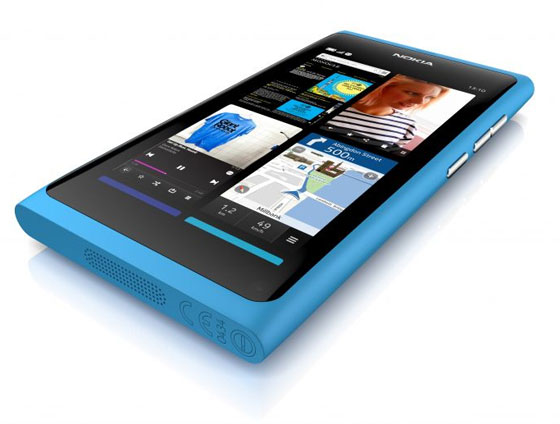
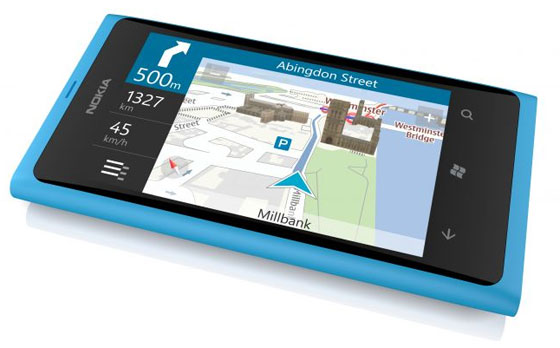
Can you spot the difference between these two models on the photo? Do not try as it is not there. The only difference is the OS inside and several minor additions. Nokia N9 was sacrificed to boost the sales of Nokia 800 Lumia, which is another mistake of Nokia. They gave up proprietary and potentially successful OS to adopt the one, which already proved to be lacklustre. Nokia N9 is not ideal and has numerous issues to be solved, but it has unique points (WP7 cannot boast anything of the kind), elegance and huge potential, which will never be implemented.
For ordinary consumers it means that the phone will never get as many apps as models on iOS, Android or even WP7. The same happened to Nokia N900. This model has no future, but is rather attractive for geeks. Those who purchased and enjoyed using Nokia N900 know what a command line is and can spend hours looking for additional apps to improve the phone. It's not even a do-it-yourself toy, but its prototype. For mass audiences it is too expensive, difficult to understand and has no additional features from the box (for example you cannot upload photos in the Twitter app, whereas alternatives do not exist). This phone has no serious innovations, but the user experience is inferior to that of modern Symbian solutions, though it is on par with WP7.
At the end of the day we have an extremely interesting collectors item, which can be attractive for those who love exotic solutions, but not for the mass market. Despite the ads campaign customers are aware of the fact and are not planning to buy the model. I am gutted not only for N9, but for Meego in general. It could have been a truly ground-breaking innovation. No matter what this is not going to happen now. Developers can also get hold of Nokia N950 as a full copy of N9, but with the QWERTY keypad. The phone will not be available in stores.
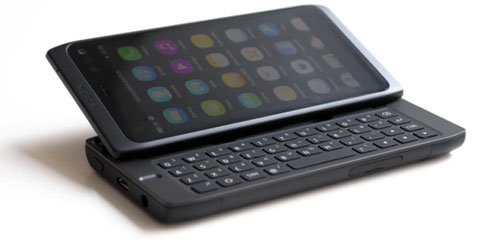
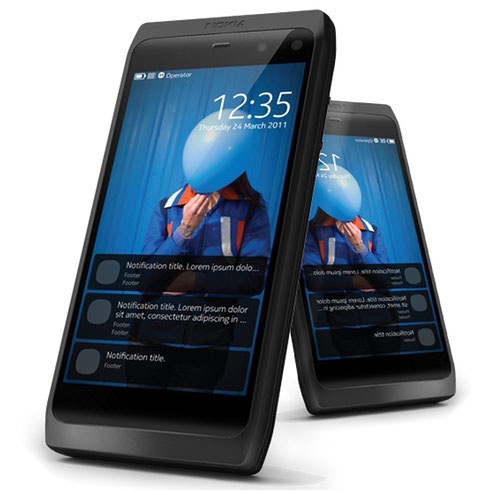
Back to the table of contents >>>
Design, Dimensions and Controls
We cannot consider the design of Nokia N9 original for the market, but it is unusual for Nokia. In a way it cites the appearance of Apple iPod as they look similarly.

Special gratitude goes to @nick_fess for the photo
The body is made of a solid piece of polycarbonate plastic, which ensures absence of moving parts, so nothing can break down here. Polycarbonate plastic is not as expensive as glass in iPhone 4/4s or metal in other solutions. This material is sometimes used even in much cheaper models (for example Asha line from Nokia being sold for under 100 Euros). The protective glass for the screen goes slightly above the plastic edges, which is unusual and nice. The case will make this glass on par with this protective material. I think the case is redundant here, unless you want to change the color of the handset this way. The body is resistant to scratches, but heavy blows are not welcome as it can get cracked. Overall the phone is very solid and reliable.


Some users complain that in their case the screen comes off, but it is not a mass issue and can be an example of a faulty batch. Moreover, it could have been caused by dropping the phone on the floor. Any service centre can fix the issue within minutes.
A solid body led to several limitations. For example, the top hosts a 3.5 mm jack and a cap for the microUSB. You have to press the cap to open it. The plastic resembles the door and this solution is rather ineffective. If you want to charge the phone from the external battery in the bag you can lose the cap. Put it on the bed and you will definitely lose the cap. A friend of mine managed to achieve it on his first day of use.


A solid body led to several limitations. For example, the top hosts a 3.5 mm jack and a cap for the microUSB. You have to press the cap to open it. The plastic resembles the door and this solution is rather ineffective. If you want to charge the phone from the external battery in the bag you can lose the cap. Put it on the bed and you will definitely lose the cap. A friend of mine managed to achieve it on his first day of use.


When you open the cap it becomes possible to withdraw the holder for the microSIM card. I see no issue with such cards as they are readily available on the market. As you know the battery is built in, which resembles Nokia N8 apart from one difference. It was so simple to replace the battery in Nokia N8, because you only had to take away a couple of screws with a special screwdriver. It is different here as you should be able to assemble and disassemble the phone.


The right side features a paired volume rocker and an on/off button. The solitary speaker is located at the bottom. Once again we have to mention body limitations. The speaker is not loud enough to hear the phone calls from pockets. The phone is 50% quieter than other solutions from Nokia (Nokia 6700 Classic, Nokia 5800, Nokia X6, etc).


The phone weighs 135g and its size is 116.45x61.2õ7.6-12.1 mm. It is felt a bit heavy in hands, but materials do not look cheap. The model fits pockets well too.
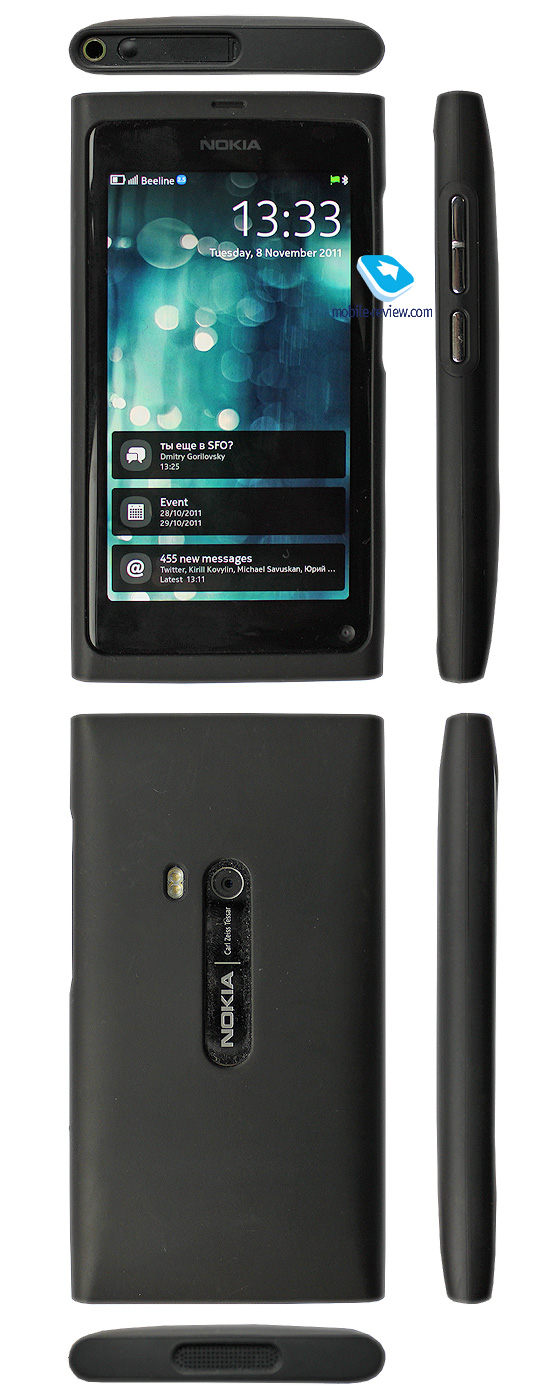
At the back we see an 8 MP camera and a LED flash.

N9 is available in white, black, cyan and magenta. Unofficially, Nokia also mentioned green and orange, but we were not given any timeline.


Back to the table of contents >>>
Screen
The display uses the AMOLED technology with anti glare cover. You can read from the screen in the sun, which is good. The resolution is 854õ480 with the size of 3.9"(16:9). Picture quality, brightness and colors are fine for the current models, but flagship solutions could boast the same one year ago. There is nothing to surprise here, though the screen is pretty decent.


Gorilla Glass has been also around one year and the same applies to the uneven screen surface.
On the downside for the screen is its size and small fonts. They are offered in cursive, which makes it difficult to read. It is especially clear in the browser, which offers an inferior picture quality to that of iPhone 4/4s and Galaxy S/S2. Screen size and fonts are responsible for that.

Against the background of the abovementioned rival models it is not convenient to use Nokia N9 for surfing, though other features are quite decent.
The capacitive screen boasts simple and pleasant touches similar to iPhone or Galaxy S2 and it is a huge step forward in comparison with Symbian phones. There is an automatic picture rotation based on the phone location. The problem is that it works only in one direction, but many apps do not support the rotation in menus. I do not have any explanation and I think it is a serious disadvantage, which goes against expectations from the handset.
Nokia website claims that the model sports a built-in light sensor to adapt the screen backlight depending on the background light. Unfortunately, it is not true, because such an option is not available from the menu. The sensor is here, but the appropriate support will be added later on. Sadly, there are many ambiguities between the official description and the real life situations.
Back to the table of contents >>>
Battery
The phone uses a 1450 mAh Li-Ion non-removable battery. The manufacturer’s quoted lifetime figures are 380 hours of standby or 11 hours of phone calls. Within Moscow networks the phone’s battery lasts for about 2 days with 40 minutes of phone calls and an hour of other functions active a day. It takes about two and a half hours to charge the battery. In the phone settings you can view detailed info on the battery charge and remaining time on battery.
The phone features a battery saving mode that can be automatically enabled when the battery reaches a certain depletion level. It is a nice feature to have although it is not quite clear what is done when it’s active – it turns down the brightness level but it surely must do something else.

One of the strongest sides of this phone and the MeeGo platform is the battery life. The phone can easily give you two days on battery and it is quite an achievement as compared to Android smartphones and it is pretty comparable to iPhone’s battery life.
However, some apps dramatically increase power consumption especially some of those that work on the background. I am not sure whether the reason is the apps themselves or the phone’s settings. But you should keep in mind that certain applications can kill the battery very quickly so if you are not happy with the battery life time you’d better check the apps you have been using lately.
Some users reported the charging indicator issues – it does is not flashing during charging and does not lit when the battery is fully charged. Here’s the discussion of this problem on the Nokia website.
Nokia’s service centers do not yet have a description of this issue and it remains unclear what causes the indicator to go rogue, sometimes the issues goes away on its own. Anyway, the problem is not that big.
Back to the table of contents >>>
Memory and Storage
The phone is available in two variants with 16 or 64 GB of storage on board and neither of them has a memory card slot.
The storage distribution of the 64 GB version is as follows: 4.2 GB is reserved for apps (2GB already occupied out-of-box), app data – 2.1 GB, user data 57.7 GB.
The figures for the 16 GB (15.79 GB) version: 4.2GB for apps (2GB already occupied), app data – 2.1 GB, user data – 9.5 GB.

The phone features 1GB of system memory. However, different OS require different amount of memory for the same tasks so it all really depends on the system memory requirements in the end and a direct comparison of memory size would be irrelevant.
The manufacturer boasts of the most advanced multitasking ever in Nokia N9 mostly thanks to the hefty 1GB of system memory. Active apps are never force closed and they take up very little system memory (at least the standard apps do). I admit I am impressed by the phone’s multitasking as far as the bundled apps are concerned: you can view the icon list of all the active apps – Nokia says the phone supports up to 70 active apps and other processes. And they all work fine except when you have a dozen of active apps it gets tricky to navigate in the active apps menu and that’s where some issues lie.
The OS apparently does not have an auto memory clearing feature – to be precise there is one but it only works when the phone is experiencing serious issues. In the settings you can enable app shut down by pulling the screen down since by default apps are always only minimized and it is a big disadvantage. For example, if you watch a non-converted video and then open an MS Word document the phone will be lagging heavily and might even reboot. On the video for this review you can see what I am talking about and it can happen any time.
Both Android and iOS have system features for this reason that don’t require any user activity – the OS decided on its own which app to stop and N9 cannot do that which is a real downer. Some reader who saw how many apps were running in my N9 commented angrily that it was not a fair comparison but they seemed to have forgotten that other OS do the job automatically. Users should not worry about how many apps are running at the moment and which ones they should close – the device should be working for users not vice versa.
The phone uses a single core 1GHz ARM Cortex A8 TI OMAP 3630 CPU and the PowerVR SGX530 graphical accelerator. The pone is quite fast and only lags when you really push it. I think its performance is comparable to current top Androids like Samsung Galaxy S and Sony Ericsson Arc. However, it is not as fast as the dual core smartphones and it is apparent when you scroll through menus – video rendering is not as fast but, all in all, its performance will satisfy most users.
Back to the table of contents >>>
Connectivity. Bluetooth, USB, WiFi, NFC
USB. There are three USB modes:
- Data Storage (Mass Storage USB) –You can browse the phone storage and you don’t need any drivers.
- Sync&connect. PC syncing.
Data transfer rate is about 12MB/s (depends on your PC and its OS). The battery is also being charged when the phone is connected to a PC via USB.
Bluetooth. The phone uses the old 2.1+EDR standard but it’s no problem since the 3.0’s only advantage is data transfer rate while all accessories work just the same.
The phone supports the following Bluetooth profiles: Headset, Handsfree, Serial Port, Dial Up Networking, File Transfer, Object Push, Basic Printing, SIM Access, A2DP. Bluetooth headsets work with N9 just fine.
Wi-Fi. The phone supports 802.11 b/g/n standards and it is not the first phone on the market with the full range of Wi-Fi standards. There is, however, an issue – searching for networks takes forever. It takes up to one minute for the phone to find anything. The reason may be in the quality of networks but in most places I searched for networks it took a really long time. As for the rest, the Wi-Fi features work fine.
NFC. N9 is one of the first phones with the NFC feature. I had a chance to test it in real life in the US together with Google Wallet in stores that offer this Google service. With the first software version nothing at all worked, with the second version I could not read NFC tags in Google Wallet. So after all, NFC is completely useless unless you use it with another phone with NFC to transfer files.
Back to the table of contents >>>
Camera
Nokia N9 features a unique camera as well as a number of very interesting photo solutions unorthodox for the phone market. For example, most phones nowadays have the screen aspect ratio of 16:9 while older phones had 4:3. So, in order to fit the image from the camera to the screen you can either zoom it (post process it from a 4:3 image) or crop it. Nokia N9 uses a 8.7 MPix matrix and the phone crops the picture to the 16:9 ratio. The result is an ‘honest’ 7 MPix image. And if you shoot 4:3 ratio images you pictures still don’t get cropped. Look at the example below and you will see how the camera works.
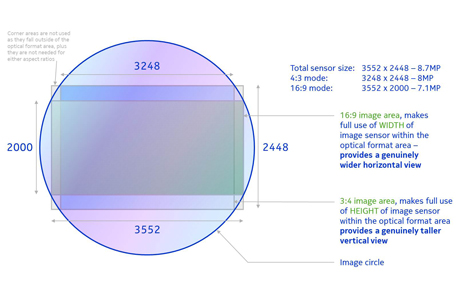
Nokia N9 camera specifications:
- Resolutions (Max) 3248 x 2448 for 4:3, 3248 x 2160 for 3:2, 3552 x 2000 for 16:9
- Aperture 2.2, focal length 28 ìì
- Autofocus, AF sensor, fixed focus for video shooting
- Focus from 10cm to infinity
- X4 Digital zoom (also for video shooting)
- Geotags with place names (can be turned off)
- Add author info feature
- Video shooting up to 720p (1280x720, 30 fps)
- Two microphones, stereo sound for video shooting

The developers say that when designing this camera they were severely limited in the available space so the camera is 70% smaller than that in Nokia N8. In my opinion, the comparison is not valid as N8 is a camera phone and it was designed for a different purpose. Anyway, N9 makes very decent pictures on a sunny day. By default, the camera makes 16:9 pictures but you can switch to the 4:3 ratio if you like it better.
Unfortunately, there are no hard button controls for the camera everything is on the screen. It makes you lose time to find the right icon but the phone makes it up for you by being a very speedy camera. Nokia proudly call it the fastest camera on the market but they exaggerate. Some phones are still faster like e.g. Sony Ericsson Xperia Ray. But the comparison is pointless since N9 fast enough for most situations. It is fast indeed but not the fastest one.
You can tap to focus on an object both for making pictures and videos. There is also a face recognition feature (faces are marked by blue squares). As a rule, you don’t need to manually focus if the object is farther than 25 cm/10 in away from the camera as it does its job well enough on its own. But for macro you will have to tap to focus and wait for some time to get a decent picture. Like at the example below you can have difficulties if the object is not still.
As I have mentioned all the controls are on the screen and you cannot change photo settings quickly but thankfully it’s not complicated at all and the number of settings is quite impressive. You can choose a scene: Automatic, Macro, Landscape, Portrait, Night, Sports; flash settings: on/off/red eye effect removal; white balance settings: auto, sunny, fluorescent, incandescent; exposition correction from -2 to +2.
Filters (available from the first firmware update) – black&white, sepia, vivid, negative, solarize.
ISO level – auto, 100, 200, 400 and 800.
You can select the image aspect ratio: 16:9, 4:3, 3:2. You can enable face recognition and auto focus on faces. You can add the author name – your name or whatever you want as a tag automatically added to all pictures. There are geotags (regular) and you can enable automatic geotags translation into names of countries, cities and districts (requires Internet connection).
The camera’s interface changes orientation if you rotate the phone. There is a nice feature concerning the image preview – you can choose the preview time from a couple of seconds to indefinitely while still being able to zoom in. Nokia claims this feature is unique to this phone only but Samsung Galaxy S2 has it too.
The bundled photo editor is a bit unusual. It is quite basic and does not have any cool features. The strange thing is that it does not prompt you to save an edited picture under another name as we are used to. The thing is Nokia N9 automatically saves the original and the edited version of the picture but when you view your pictures you won’t find the original picture. Instead, you can revert any picture back to the original any time. I think his feature is completely useless as anyone who uses a photo editor is surely aware about file rewriting and will care to change a pictures name if he wishes to.

The LED flash is quite bright and this has both upsides and downsides. I believe the example below illustrate what I mean.
All in all, it is a decent average camera. It looks good in its price range and well enough generally on the market. It does not make breathtaking pictures but decent ones still.
The camera can shoot video with resolution up to 1280x760 (720p) at 30fps. The phone features two mics so also get stereo sound with your videos. There is nothing else to say about this mode – you can assess the video quality on the example below.
- Video sample 1 (mp4, 28,7 MB) >>>
- Video sample 2 (mp4, 14,6 MB) >>>
- Video sample 3 (mp4, 8,6 MB) >>>
- Video sample 4 (mp4, 11,2 MB) >>>
- Video sample 5 (mp4, 27,0 MB) >>>
The next part of Nokia N9 review concerns the MeeGo interface and bundled software. We will also give our final verdict about this Nokia flagship.
Do you want to talk about this? Please, go to our Forum and let your opinion be known to the author and everybody else.
Back to the table of contents >>>
Eldar Murtazin (eldar@mobile-review.com)
 Twitter Twitter
 Livejournal Livejournal
Translated by Maxim Antonenko (maxantonenko@ukr.net), Robert Mugattarov (mugattarov@gmail.com)
Published — 29 November 2011
Have something to add?! Write us... eldar@mobile-review.com
|
















































